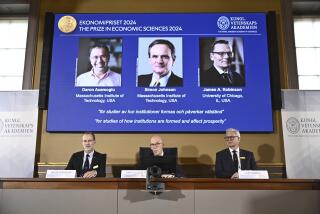Ronald Coase dies at 102; economist was oldest living Nobel laureate
- Share via
Ronald Coase, a British-born University of Chicago economist whose Nobel Prize-winning work on the role of corporations stemmed from visits in the early 1930s to American companies including Ford Motor Co. and Union Carbide Corp., has died. He was 102.
Coase, who had been the oldest living Nobel laureate, died Monday at St. Joseph Hospital in Chicago, the university announced. No cause was given.
The Royal Swedish Academy of Science awarded Coase the 1991 Nobel in economics “for his discovery and clarification of the significance of transaction costs and property rights for the institutional structure and functioning of the economy.”
Coase built his career offering insights on the legal precepts and institutions, such as the corporation, on which economics is built. He was one of the first economists to treat the size and function of companies as a subject worthy of more than incidental attention.
His 1937 article, “The Nature of the Firm,” explained how the costs of economic transactions — including time, fees and what became known generally as overhead — determine the size of the companies that arise to carry out the transactions.
The Nobel committee wrote that Coase “showed that traditional basic microeconomic theory was incomplete because it only included production and transport costs” and “neglected the costs of entering into and executing contracts and managing organizations.” This new way of thinking had implications for corporate and contract law as well as for the structure of the financial system.
Coase further explored transaction costs in a 1960 paper, “The Problem of Social Cost,” which examined how to address harm caused by business, such as pollution from a factory. Holding the company liable and ordering it to pay money to an affected property holder is less likely to yield an optimal result than having the parties negotiate, he wrote.
The paper spawned what became known as the Coase Theorem, which conservative legal activists cited to support free-market solutions rather than government regulation.
“All it says is that the people will use resources in the way that produces the most value, that’s all,” Coase said of the theorem in an interview with Reason magazine published in 1997. “I still think it’s an obvious point. You wouldn’t think there was a need for a Coase Theorem, really.”
Ronald Harry Coase was born Dec. 29, 1910, in Willesden, a suburb of London. His father was a telegraph operator in the post office, where his mother also worked until their marriage.
At the London School of Economics & Political Science, starting in 1929, Coase was influenced by the teachings of Arnold Plant, a commerce professor newly arrived from the University of Cape Town in South Africa.
“What Plant did was to introduce me to Adam Smith’s invisible hand,” Coase wrote in an autobiography for the Nobel Foundation. “He made me aware of how a competitive economic system could be coordinated by the pricing system.”
For his third year of studies, the University of London awarded him a Sir Ernest Cassel Traveling Scholarship, and he spent the 1931-32 school year in the United States, studying the different structures of American industries. His visits to factories and businesses shaped his ideas on transaction costs and the role of firms.
He taught at the Dundee School of Economics and Commerce from 1932 to 1934, at the University of Liverpool from 1934 to 1935 and then at the London School of Economics. During World War II he worked for the U.K. Forestry Commission, then at the Central Statistical Office, part of the Offices of the War Cabinet. He returned to the London School of Economics in 1946.
Moving to the U.S. in 1951, he worked at the University of Buffalo before joining the University of Virginia in 1958.
Building on research he had done in Britain on the British Broadcasting Corp., he studied the Federal Communications Commission’s allocation of the radio frequency spectrum. In a 1959 article, he advocated selling frequencies to the highest bidders — a policy enacted in 1994 after decades of giving them away for free.
He joined the University of Chicago Law School as an economics professor in 1964 and served as editor of the Journal of Law and Economics until 1982. He became professor emeritus in 1981.
His final book, “How China Became Capitalist,” co-written with a former student Ning Wang, was published last year, when he was 101.
His wife of 75 years, Marian, died in 2012. He has no immediate survivors.
More to Read
Start your day right
Sign up for Essential California for the L.A. Times biggest news, features and recommendations in your inbox six days a week.
You may occasionally receive promotional content from the Los Angeles Times.








